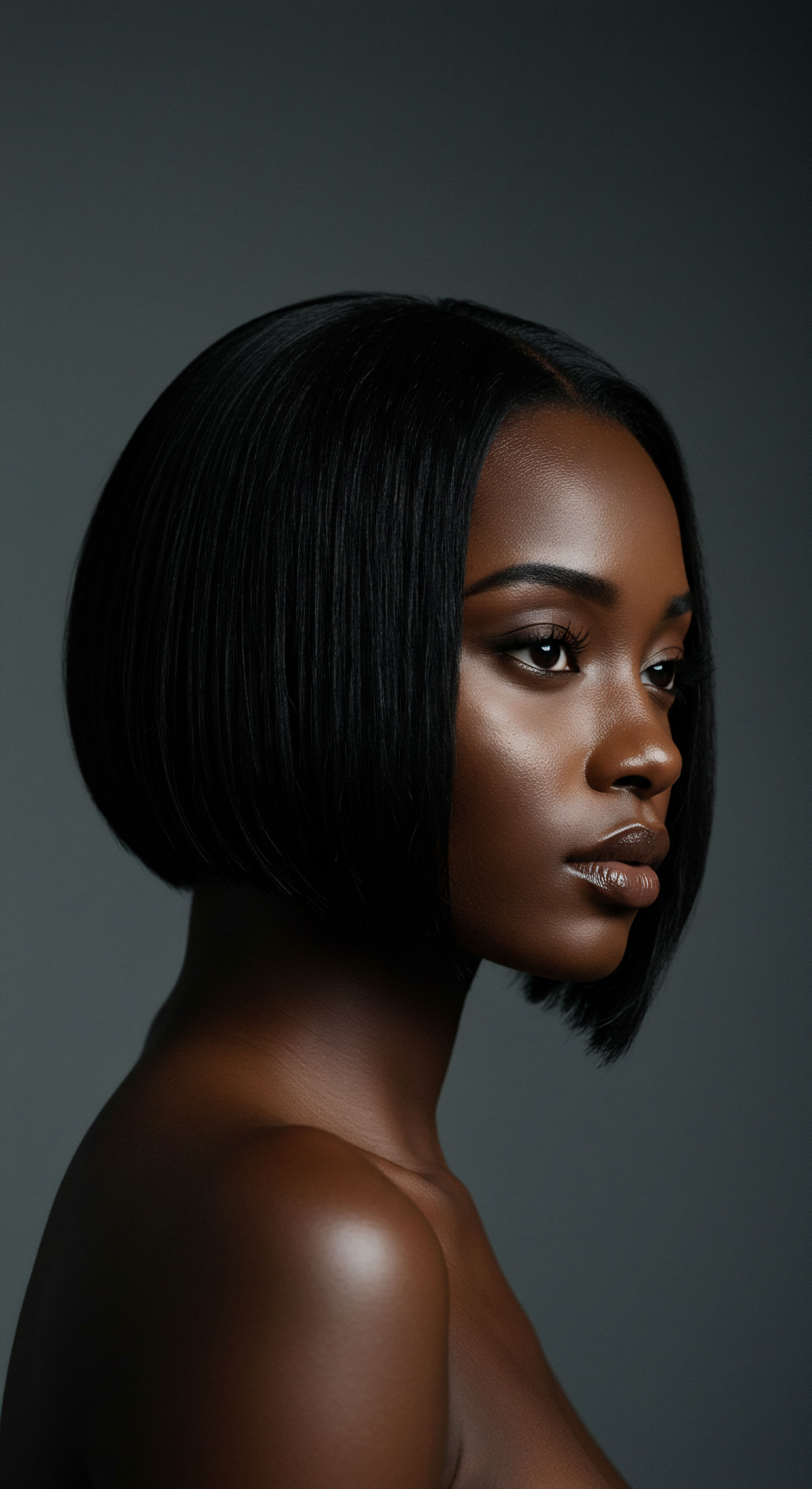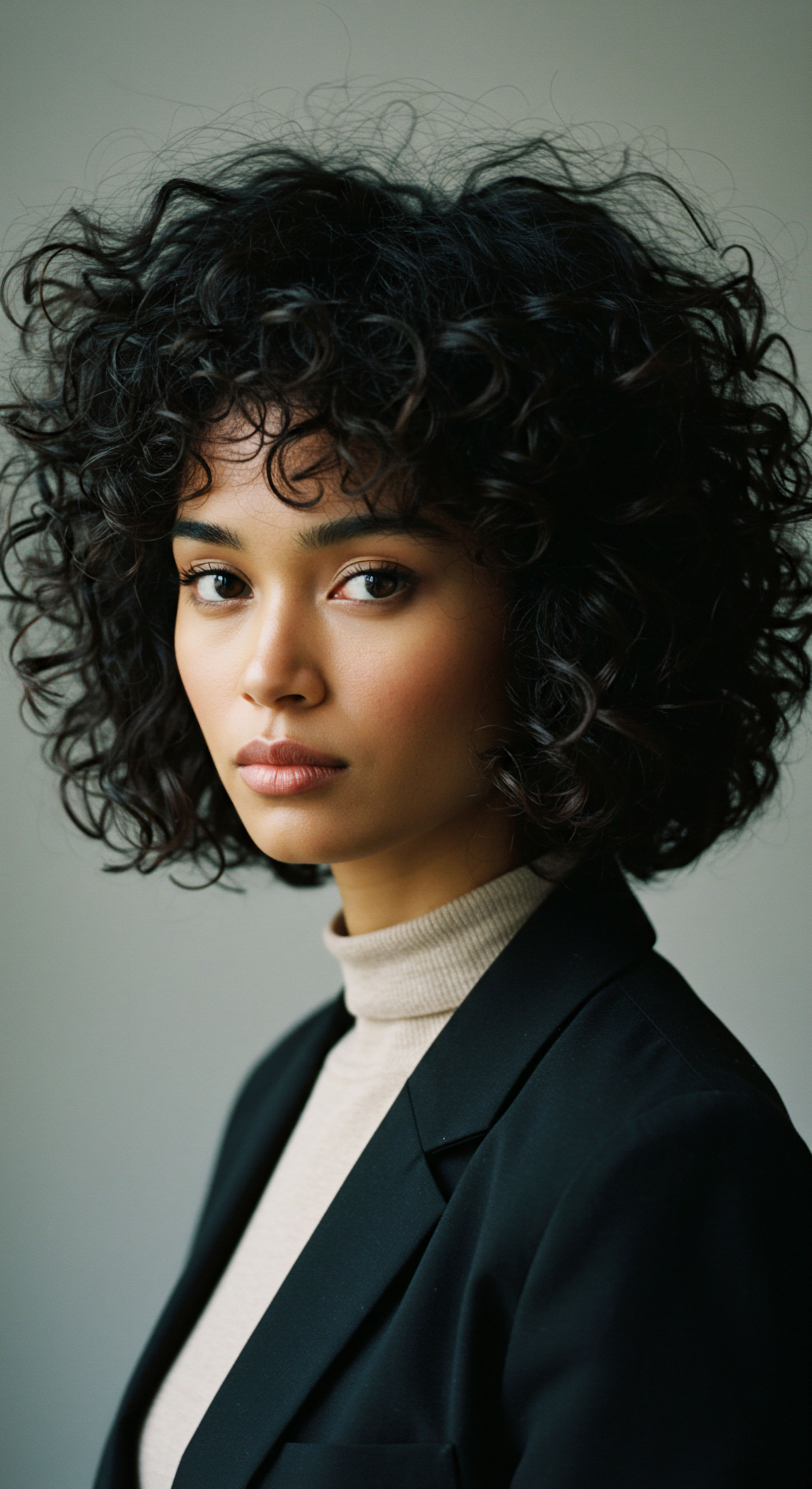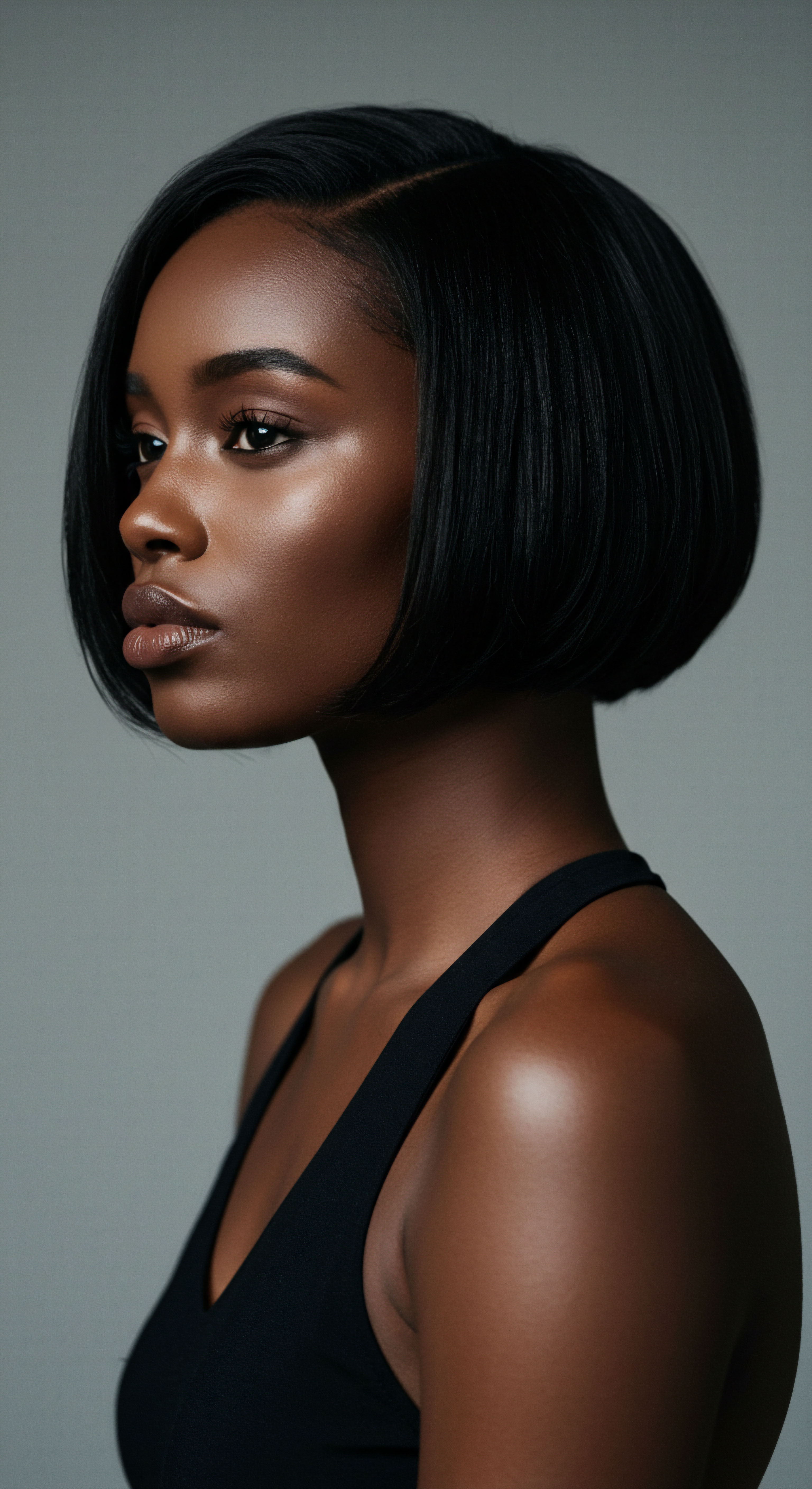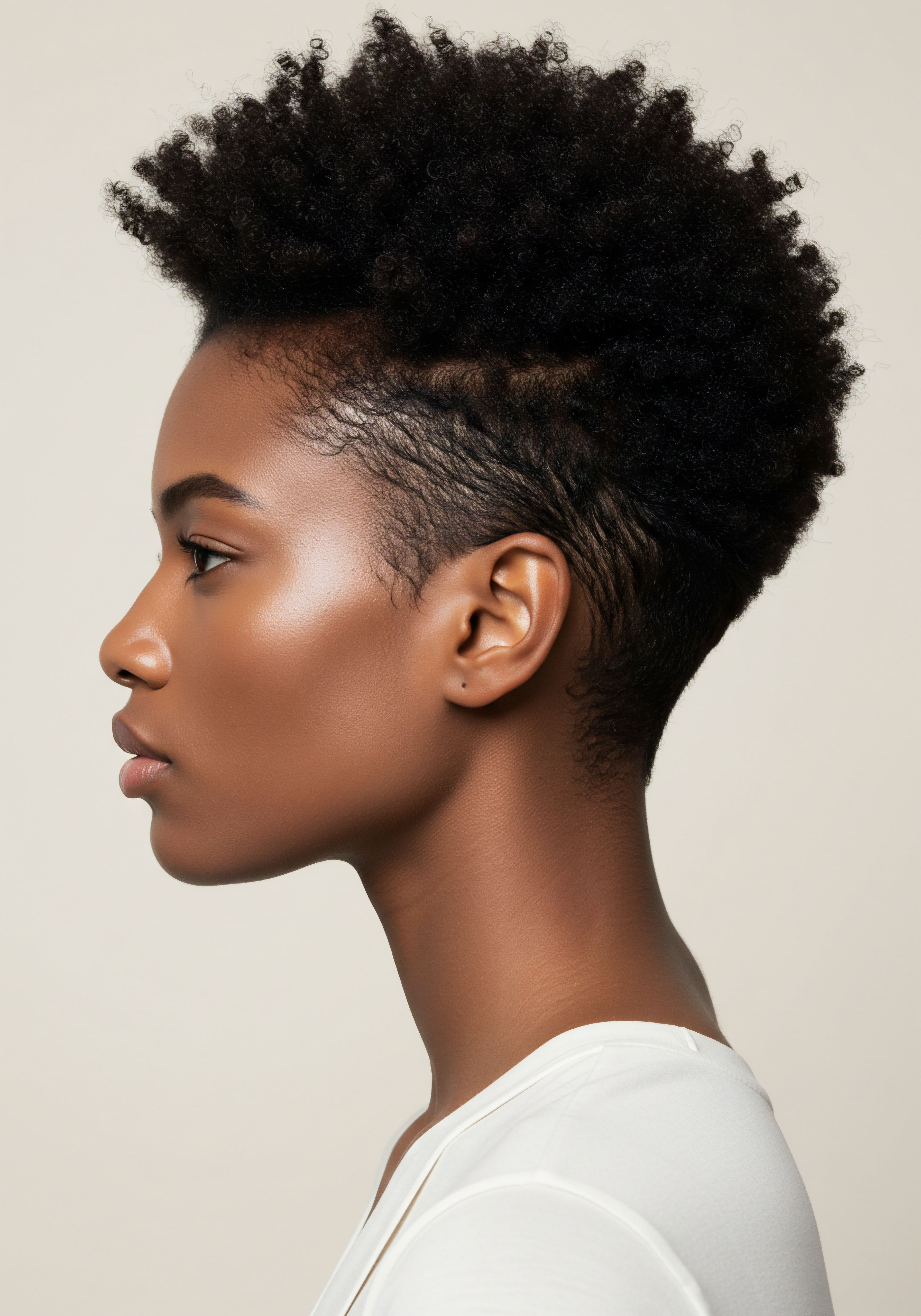
Roots
The journey of textured hair care practices stretches back through millennia, far beyond the confines of modern beauty aisles or fleeting trends. It begins not in a laboratory, but in the communal spaces of ancient civilizations, where hair was more than mere adornment; it was a living record, a profound expression of identity, status, and spirit. To truly comprehend the care rituals of today, one must first feel the resonance of these ancestral whispers, understanding how history has shaped not only our hair, but our perception of it.

Ancient Echoes and Early Meanings
Across various African societies, hairstyles served as a visual lexicon, communicating intricate details about an individual’s life. A glance could reveal a person’s age, marital status, tribal affiliation, wealth, or even their rank within the community. In West Africa, for instance, specific braiding patterns might signify a woman’s readiness for marriage or a warrior’s preparation for battle.
This deep connection between hair and social standing meant that hair care was not a solitary act, but a communal one, often involving family members sharing techniques and stories. These moments of grooming fostered connection and passed down knowledge through generations.
Across ancient African societies, hair was a vibrant, living canvas, speaking volumes about an individual’s identity and social standing.
Ancient Egyptians, too, held hair in high regard, adorning elaborate braids with beads, jewels, and gold. They believed hair could ward off ill influences and bring good fortune, showcasing its spiritual significance. This early reverence for hair, particularly its textured forms, established a foundation of care that was holistic, linking physical appearance with spiritual and social well-being. Ingredients derived from the natural world—oils, herbs, and clays—were the staples of these ancient regimens, selected for their nourishing and protective qualities.

The Earliest Tools and Techniques
The tools of early textured hair care were simple, yet remarkably effective. Combs with wide teeth, designed to navigate the delicate nature of coily and kinky strands, were essential. Archeological findings confirm the presence of such combs dating back thousands of years. Beyond combs, hands were the primary instruments, capable of the precise sectioning and manipulation required for intricate braiding and twisting.
- Combs ❉ Early combs, often crafted from wood or bone, featured wider teeth to gently detangle and style.
- Natural Oils ❉ Plant-based oils and butters, such as shea butter or palm oil, were used for moisture retention and scalp health.
- Braiding ❉ Techniques like cornrows and various forms of plaiting provided protective styling, preserving hair from environmental elements.
These practices laid the groundwork for many techniques still employed today, demonstrating a timeless understanding of textured hair’s unique needs. The focus was on preservation and celebration, rather than alteration.
| Ingredient Shea Butter |
| Historical Origin West Africa |
| Primary Use Moisture, scalp nourishment, protection |
| Ingredient Olive Oil |
| Historical Origin Mediterranean, North Africa |
| Primary Use Conditioning, shine, scalp health |
| Ingredient Henna |
| Historical Origin North Africa, Middle East, India |
| Primary Use Color, conditioning, strengthening |
| Ingredient Clay Powders |
| Historical Origin Various ancient cultures |
| Primary Use Cleansing, oil absorption, volume |
| Ingredient These natural elements formed the bedrock of ancient textured hair care. |

Ritual
Stepping from the ancient echoes into the more recent past, we find that the practical wisdom of textured hair care transformed, adapting to the harsh realities of forced displacement and societal pressures. The daily or periodic practices that shape our hair experiences today carry the weight of survival, resilience, and a quiet defiance. This section guides us through how these rituals, once rooted in cultural celebration, became acts of preservation, sometimes even of protest, offering gentle guidance through the evolution of techniques and methods.

The Shadow of Enslavement and Its Hair Legacy
The transatlantic slave trade marked a devastating rupture in the continuity of African hair traditions. Millions were forcibly removed from their homelands, stripped of their identities, and often had their heads shaved upon arrival in the Americas. This brutal act aimed to dehumanize, severing connections to ancestral customs and the communal grooming rituals that sustained them. Deprived of their traditional tools, oils, and the time for elaborate care, enslaved Africans had to adapt, using whatever was at hand—cooking oil, animal fats, or butter—to manage their hair.
The era of enslavement profoundly altered textured hair practices, transforming communal rituals into private acts of survival and resistance.
A painful hierarchy emerged within enslaved communities, where straighter hair was often associated with perceived social or economic advantages, particularly for those working in the “big house”. This gave rise to practices like applying lye, string wrapping, or using heated butter knives to straighten hair, often resulting in scalp burns and damage. These desperate measures, while physically harmful, were sometimes adopted as a means of navigating an oppressive system, seeking even a semblance of safety or opportunity.

Post Emancipation Adaptations and Emerging Technologies
Even after emancipation, the pressures to conform to Eurocentric beauty standards persisted. Straight hair was widely perceived as more “civilized” or “professional,” creating a strong societal pull towards altering natural textures. This period saw the rise of new tools and products designed to achieve straightened styles.
The hot comb, initially invented by a French stylist but popularized by Black entrepreneurs like Madam C.J. Walker, became a staple in many households. Heated on a stove, this tool allowed for temporary straightening, though often at the cost of heat damage and burns. Walker’s company, along with others, also developed hair growth serums and pomades, recognizing the unique needs of Black hair, even as some of her products contributed to the straightening trend.
The early 20th century also witnessed the advent of chemical relaxers. Garrett Augustus Morgan Sr. a Black inventor, accidentally discovered a hair-straightening formula while working on sewing machines in 1909. His initial product, G.A.
Morgan’s Hair Refiner, laid the groundwork for the chemical relaxer industry. These lye-based solutions, and later “no-lye” alternatives, offered more permanent straightening, becoming a widely adopted practice for decades.
- Hot Comb ❉ A metal comb heated to straighten hair, popular from the late 1800s onward.
- Chemical Relaxers ❉ Formulations, often containing strong alkalis, designed to permanently alter the hair’s curl pattern.
- Hair Grease and Pomades ❉ Products used to slick down hair, add shine, and aid in straightening efforts.
The widespread adoption of these methods highlights the profound impact of societal pressures on personal grooming choices, illustrating a complex interplay between cultural identity and the desire for social acceptance.

Relay
As we move through history, the story of textured hair care shifts from adaptation to assertion, from necessity to conscious choice. This “Relay” section delves into the profound interplay of science, culture, and intricate details that have shaped modern textured hair practices. It invites a deeper consideration of how movements for social justice and cultural pride have reshaped perceptions and innovations, moving beyond surface-level discussions to a more profound understanding, supported by data and scholarly insights.

Civil Rights and the Crown of Identity
The mid-20th century brought a profound reawakening. The Civil Rights Movement in the United States, alongside the “Black Is Beautiful” movement, sparked a powerful rejection of Eurocentric beauty standards that had long dominated perceptions of textured hair. The Afro hairstyle emerged as a potent symbol of Black pride, cultural freedom, and political resistance. It was a visible declaration of self-acceptance, encouraging individuals to wear their natural coils and kinks with dignity and defiance.
This period saw a conscious effort to reclaim ancestral styles like cornrows and braids, which had been functional during enslavement but now regained their status as cultural markers. The shift was not merely aesthetic; it was a psychological liberation, challenging generations of internalized beliefs that natural hair was “unruly” or “unprofessional”. This collective embrace of natural texture also spurred the creation of new products and educational resources specifically for textured hair, as existing markets had largely ignored these needs.

The Modern Renaissance and Its Complexities
The late 20th and early 21st centuries witnessed a significant resurgence of the natural hair movement, amplified by digital platforms and social media. This period has been characterized by a widespread embrace of diverse textured styles, from coils and curls to locs and twists, and a growing demand for products that nourish and support natural hair health.
However, this modern renaissance is not without its complexities. Despite increasing acceptance, discrimination against textured hair persists in professional and educational settings, often rooted in lingering Eurocentric biases. The CROWN Act in the United States, a legislative effort to prohibit discrimination based on hair texture and style, stands as a testament to the ongoing struggle for hair freedom. As of this writing, it has been signed into law in 22 states and one US Territory, though federal passage is still pending.
The journey of textured hair care reflects a continuous dialogue between historical oppression and enduring cultural resilience.
A particularly poignant illustration of this ongoing challenge can be seen in a 2023 survey study which revealed that 61% of Black respondents reported using chemical straighteners because they “felt more beautiful with straight hair”. This statistic, while concerning given the documented health risks associated with certain relaxer chemicals like parabens and phthalates (linked to increased risk of early puberty, uterine fibroids, and cancer), underscores the deep-seated societal pressures that continue to influence hair choices. It highlights a critical tension ❉ the celebration of natural hair alongside the persistent societal conditioning that equates straight hair with beauty or professionalism. This duality presents a compelling area for continued advocacy and education, ensuring that personal choice is truly free from the weight of historical bias and systemic prejudice.

What Scientific Understanding Shapes Modern Textured Hair Care?
Modern textured hair care is increasingly informed by a deeper scientific understanding of hair anatomy and physiology. Cosmetic chemists and trichologists now focus on the unique helical structure of textured hair, its propensity for dryness due to the winding path of its cuticle, and its delicate nature which makes it prone to breakage if mishandled. This scientific grounding allows for the development of products specifically formulated to address these needs, emphasizing hydration, gentle cleansing, and protective styling.
- Porosity ❉ Understanding how hair absorbs and retains moisture, a key factor for textured hair.
- Elasticity ❉ Assessing the hair’s ability to stretch and return to its original state, indicating its health.
- Scalp Health ❉ Recognizing the scalp as the foundation for healthy hair growth, particularly for protective styles.
The evolution of product formulations reflects this knowledge, moving away from harsh chemicals towards ingredients that support the hair’s natural integrity. The conversation has shifted from “taming” textured hair to nourishing and celebrating its innate beauty, recognizing that true hair health comes from understanding and respecting its unique characteristics.
| Historical Period Pre-Colonial Africa |
| Dominant Products/Practices Natural oils, herbs, elaborate braids |
| Underlying Societal Aim Cultural identity, social status, spiritual connection |
| Historical Period Slavery/Post-Emancipation |
| Dominant Products/Practices Animal fats, lye, hot combs, early relaxers |
| Underlying Societal Aim Survival, assimilation, conformity to Eurocentric ideals |
| Historical Period Civil Rights Era (1960s-70s) |
| Dominant Products/Practices Minimal products, focus on Afro, natural styles |
| Underlying Societal Aim Black pride, political statement, cultural reclamation |
| Historical Period Late 20th Century (Post-80s) |
| Dominant Products/Practices Chemical relaxers, Jheri curls, weaves |
| Underlying Societal Aim Mainstream acceptance, convenience, varied styling |
| Historical Period 21st Century Natural Hair Movement |
| Dominant Products/Practices Curl creams, deep conditioners, protective style products |
| Underlying Societal Aim Hair health, self-acceptance, celebrating natural texture |
| Historical Period Product evolution mirrors shifts in societal pressures and cultural identity. |

Reflection
The journey through the historical influences on textured hair care practices reveals a profound narrative, one that extends far beyond simple aesthetics. It is a story of resilience, cultural survival, and the persistent quest for self-determination. From ancient traditions where hair communicated identity and status, through periods of forced alteration and societal pressure, to modern movements of reclamation and celebration, textured hair has remained a powerful symbol.
The choices made about hair, whether to straighten, coil, braid, or loc, carry echoes of collective histories and personal assertions. Understanding this intricate past allows us to approach textured hair care not as a set of rules, but as a living legacy, inviting us to honor our strands with informed care and profound respect.

References
- Byrd, A. D. & Tharps, L. R. (2014). Hair Story ❉ Untangling the Roots of Black Hair in America. St. Martin’s Griffin.
- Patton, T. O. (2006). Hey Girl, Am I More Than My Hair? African American Women and Their Struggles with Beauty, Power, and Hair. Peter Lang Publishing.
- Mercer, K. (1994). Welcome to the Jungle ❉ New Positions in Black Cultural Studies. Routledge.
- Banks, I. (2000). Hair Matters ❉ Beauty, Power, and Black Women’s Consciousness. New York University Press.
- Ellington, T. (2014). Natural Hair ❉ The Ultimate Guide to African American Hair Care. Millbrook Press.
- Massey, L. (2001). Curly Girl ❉ The Handbook. Workman Publishing Company.
- Hall, S. (1997). Representation ❉ Cultural Representations and Signifying Practices. Sage Publications.
- Davis, A. (1974). Angela Davis ❉ An Autobiography. Random House.
- Walker, A. (2001). On Her Own Ground ❉ The Life and Times of Madam C. J. Walker. Washington Square Press.
- Hooks, B. (1992). Black Looks ❉ Race and Representation. South End Press.